
Sauce beef, this ancient Chinese delicacy, seems to possess endless magic that captivates people. Through meticulous cooking, sauce beef exhibits alluring colors and rich aromas. Its exterior showcases a deep brown sheen, resembling an artwork that has been aged over time. When sliced open, the inner meat reveals a tender pink hue, as if concealing shy secrets of a young girl’s heart. Taking a bite of sauce beef, its velvety texture dances on the taste buds, leaving a lingering aftertaste. Its flavor is both rich and unique, striking a perfect balance between sweetness and saltiness. Upon savoring it slowly, one can also sense a faint soy fragrance, enhancing the dish’s overall mouthfeel. The tender and juicy meat is irresistible, as each bite seems to narrate an ancient story, transporting individuals to the river of history.
Ingredients for Sauce beef:
| Beef | 500g |
| Green onion | 15g |
| Light soy sauce | 20g |
| Cooking wine | 5g |
| Salt | 2g |
| Ginger | 5g |
| Amomum tsao-ko | 6g |
| Fragrant leaves | 3g |
| Cinnamon bark | 5g |
| Star anise | 6g |
| Sichuan Pepper | 5g |
| Oyster sauce | 5g |
| Dark soy sauce | 2g |
| Pepper powder | 2g |
| Sweet bean sauce | 10g |
| Fermented tofu | 5g |
| Dried chilli | 8g |
Step:
1.Firstly, we prepare 500 grams of beef, preferably a cut suitable for stewing like beef chuck or brisket. Place the beef in a bowl and pour in enough water to cover it completely. This helps remove any blood and impurities from the beef and makes it more tender. To ensure the quality of the beef, we need to change the water every half an hour. This helps remove any sediment on the surface of the beef, maintaining its purity. After two hours, gently squeeze the beef to release any excess blood. Then thoroughly wash the beef to remove any remaining stains and odors. Once done, remove the cleaned beef from the water and set it aside. At this point, the beef is ready for the next step of processing and seasoning.
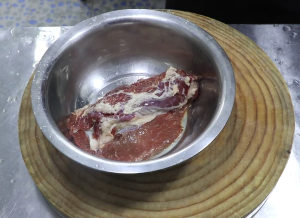
2.Next, we will marinate the beef. Start by preparing the white part of a large onion, cutting it into sections after splitting it in the middle, and adding it to the beef. This adds fragrance and flavor. Then add 20 grams of light soy sauce, 5 grams of cooking wine, 2 grams of salt, and 2 grams of black pepper. Mix well to evenly coat the beef with the marinade, ensuring that each piece absorbs the seasoning fully. Let the beef marinate for two hours. During this time, it is recommended to flip the beef occasionally to ensure even penetration of the flavors, enhancing the balance of taste. As the beef marinates, it gradually absorbs the flavors, becoming more flavorful and tender. Once the marinating process is complete, we can proceed to the next cooking steps.
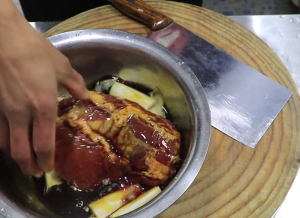
3.Next, we prepare some spices to enhance the flavor of the beef. Thinly slice a piece of ginger and add it to the bowl, adding a fresh aroma to the dish. Then add one dried chili, one piece of Amomum tsao-ko (lightly crushed and seeds removed), a few fragrant leaves, one piece of cinnamon bark, and two pieces of star anise. Additionally, you can add a pinch of Sichuan Pepper. Set these spices aside. These spices contribute their unique aromas and textures, making the braised beef more flavorful and delicious. They will simmer together with the other seasonings and beef, gradually releasing their individual fragrances during the cooking process, adding layers of richness to the dish. Now that we have all the necessary ingredients and seasonings ready, we can start making the sauce beef.
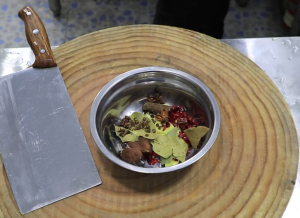
4.After marinating the beef for two hours, we need to cook it thoroughly. Pour the marinated beef and marinade into a pot and add enough water to cover the beef. Then, simmer the beef over low heat. This helps the beef release any excess blood and impurities while making the meat tender. Once it comes to a boil, some foam may appear on the surface. Skim off the foam with a strainer or spoon to keep the broth clear. Continue to boil the beef for about 2 minutes, which is sufficient to cook the beef. After cooking, we can proceed to the next step, such as transferring it to a clay pot for slow braising or other cooking methods to further season and enhance the texture. This cooked beef will be easier to absorb flavors and remove some of the excess fat and unnecessary substances, making the dish healthier and more delicious.
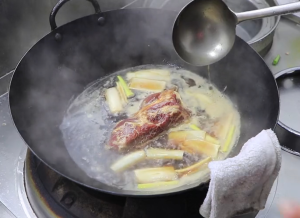
5.Once the beef changes color, prepare the clay pot. Pour the cooked beef and broth into the clay pot, ensuring that the beef is completely submerged in the broth. Then, place the clay pot over a flame and simmer on low heat for two hours. Slow cooking on low heat allows the beef to become tender gradually and allows the broth to fully infuse into the beef, enhancing its texture and flavor. During this process, it is important to maintain a stable heat and monitor the clay pot to ensure that the beef does not overcook or become mushy. The slow braising process requires patience, but it yields the best texture and flavor for the beef. After two hours of slow braising, the beef will become soft, tender, and flavorful. The broth will also become rich and fragrant due to the extended cooking time. Now, we just need to proceed with the remaining steps to complete this delicious sauce beef dish.

6.While waiting for the beef to simmer, we can prepare the sauce. Start by heating some oil in a pan and add the prepared ginger, chili, and other spices to stir-fry until fragrant. Be mindful of controlling the temperature to avoid burning the chili. Then, remove from heat or reduce to low heat, continue stirring while adding 10 grams of sweet bean sauce and one piece of fermented tofu. Stir-fry on low heat for a while longer to bring out the flavors of the sauce. If the color is not deep enough, you can add 2 grams of dark soy sauce for a deeper color, followed by 5 grams of oyster sauce for a richer taste. Next, add an appropriate amount of water and stir well to dissolve the seasonings. Increase the heat to high and let the sauce thicken until it reaches the desired consistency for the beef. This sauce will add a rich texture and flavor to the sauce beef. You can adjust the taste of the sauce according to personal preference, ensuring it complements the beef perfectly. Now that we have the sauce ready, we can proceed with the next steps.
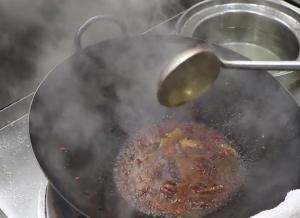
7.After simmering the beef for two hours, we will remove the clay pot from the heat and take out the cooked beef. Next, we need to strain the broth of the braised beef to remove the spices and ginger slices, ensuring a clear broth. To do this, wash the clay pot and pour the cooked beef broth through a sieve into the pot, filtering out any impurities and keeping the broth clear. Make sure all the spices and ginger slices are strained out, leaving only the beef broth. Then, pour the prepared sauce into the clay pot. Return the previously removed beef back into the pot, making sure it is fully submerged in the sauce. If needed, you can add some water to ensure the beef is completely covered by the sauce. Then, simmer the clay pot over low heat for about 30 minutes, allowing the beef to fully absorb the flavors of the sauce. This will enhance the taste and tenderness of the beef. With this step completed, we are almost ready to enjoy the aromatic and flavorful sauce beef dish.
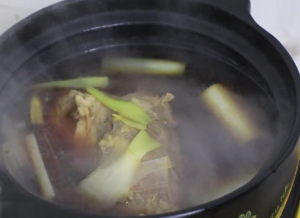
8.After the final simmering is complete, we can remove the sauce beef from the clay pot and place it in a container to cool down. During the cooling process, the sauce beef will become more firm. Once the sauce beef is completely cooled, we can start enjoying it. Slice the sauce beef into thin pieces, which allows each bite to be flavorful and easy to chew. Now, you can savor the tender and fragrant sauce beef. It can be enjoyed with rice or noodles, or used as an ingredient in hot pot dishes – all of them are delicious options. Enjoy this patiently crafted delicacy to the fullest!
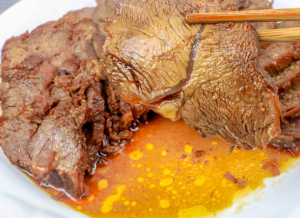
Tips:
1.For slow braising, choose cuts of beef such as beef brisket or beef shoulder that have a good amount of connective tissue and marbling. These cuts will become more tender and flavorful during the slow cooking process.
2.Avoid marinating the beef for too long. Generally, two hours is enough to allow the flavors to penetrate the meat. Marinating for too long may result in overly salty beef.
3.When slow braising the sauce beef, use low heat to ensure that the beef becomes tender and absorbs the flavors gradually. Pay attention to the cooking time to avoid overcooking or stewing the beef.
Sauce beef, the magician in the kitchen, transforms ordinary beef into a uniquely flavored dish. After a series of intricate steps, the sauce beef finally reveals its beauty before us. The deep brown exterior resembles a sturdy armor, protecting the tender flesh within. Each slice of beef is like a meticulously crafted piece of art, worthy of admiration. Taking a bite of the sauce beef, the rich meaty aroma bursts in the mouth. It is a combination of sweetness, saltiness, umami, and meatiness, creating a symphony on the taste buds. While chewing, the tenderness and elasticity of the beef are showcased, giving a sense of vitality. As the beef slowly dissolves in the mouth, the savory juices bring satisfaction.

